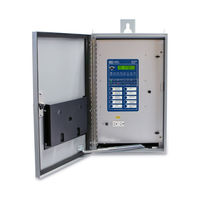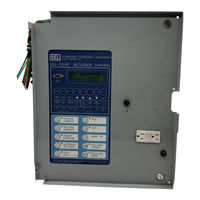Schweitzer Engineering Laboratories SEL-351R Manuals
Manuals and User Guides for Schweitzer Engineering Laboratories SEL-351R. We have 2 Schweitzer Engineering Laboratories SEL-351R manuals available for free PDF download: Instruction Manual, Quick Start Installation And User Manual
Schweitzer Engineering Laboratories SEL-351R Instruction Manual (620 pages)
RECLOSER CONTROL
Brand: Schweitzer Engineering Laboratories
|
Category: Relays
|
Size: 7 MB
Table of Contents
-
-
Introduction19
-
-
-
Logic32
-
Trip Logic40
-
Close Logic41
-
-
-
-
-
-
-
Accuracy100
-
Settings Ranges100
-
-
-
-
Settings Ranges102
-
Accuracy105
-
Torque Control107
-
-
-
Accuracy110
-
Settings Ranges110
-
-
-
Accuracy112
-
Settings Ranges112
-
-
-
Accuracy114
-
Settings Ranges114
-
-
-
Voltage Elements115
-
Voltage116
-
Accuracy119
-
-
Setting SYNCP121
-
Accuracy122
-
And V124
-
Voltage Window125
-
Voltages V129
-
-
-
Accuracy133
-
-
-
-
-
Setting ELOP = y142
-
Setting ELOP = N142
-
-
Settings Ranges144
-
Internal Enables148
-
-
-
-
Trip Logic181
-
-
Trip Setting DTT191
-
-
External Inputs193
-
Timer Settings194
-
Logic Outputs194
-
-
External Inputs199
-
Timer Settings200
-
Logic Outputs200
-
-
External Inputs204
-
Timer Settings205
-
-
-
Close Logic213
-
-
Reclosing Relay223
-
-
Lockout State224
-
-
-
Example 1236
-
-
-
-
-
Control Logic243
-
-
-
-
Input IN101245
-
Input IN102246
-
-
-
-
ON/OFF Switch248
-
-
-
-
Ogic263
-
-
Power Loss270
-
Settings Change270
-
-
Output Contacts275
-
-
-
-
-
-
Via Serial Port308
-
Via Front Panel309
-
-
Introduction297
-
-
Battery Status316
-
Metering317
-
Phantom Voltages318
-
Demand Metering318
-
Time = 0 Minutes321
-
Time = 5 Minutes321
-
Current324
-
Via Front Panel326
-
Via Serial Port326
-
Energy Metering326
-
-
-
-
Introduction409
-
-
-
-
-
-
Introduction513
-
Calibration521
-
-
-
-
-
-
Start SEL BOOT539
-
-
Operate Commands551
-
Introduction551
-
ID Message559
-
DNA Message560
-
BNA Message562
-
-
-
-
Relay Word Bits577
-
-
-
-
Overview591
-
Configuration591
-
Device Profile595
-
Object Table597
-
Data Map601
-
Point Remapping606
-
Advertisement
Schweitzer Engineering Laboratories SEL-351R Quick Start Installation And User Manual (132 pages)
Recloser Control
Brand: Schweitzer Engineering Laboratories
|
Category: Industrial Electrical
|
Size: 3 MB
Table of Contents
-
Preface
11 -
-
Overview15
-
-
Accessories16
-
-
-
-
Overview39
-
Serial Ports41
-
Commands44
-
-
-
Pushbuttons57
-
-
Overview65
-
-
-
Overview99
-
-
Phase Trip103
-
Ground Trip104
-
-
-
Phase Fast Curve107
-
-
Reclosing Tests112
-
Reset Times113
-
-
-
Overview115
-
Battery Status116
-
Advertisement
Related Products
- Schweitzer Engineering Laboratories SEL-351S
- Schweitzer Engineering Laboratories SEL-351-1
- Schweitzer Engineering Laboratories SEL-351-0
- Schweitzer Engineering Laboratories SEL-351-3
- Schweitzer Engineering Laboratories SEL-351-2
- Schweitzer Engineering Laboratories SEL-351-4
- Schweitzer Engineering Laboratories SEL-351-5
- Schweitzer Engineering Laboratories SEL-351-6
- Schweitzer Engineering Laboratories SEL-351-7
- Schweitzer Engineering Laboratories SEL-351

